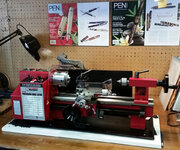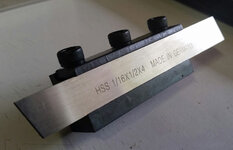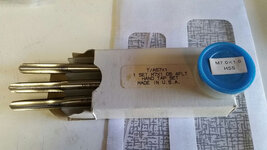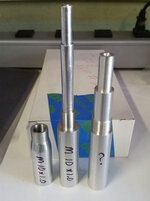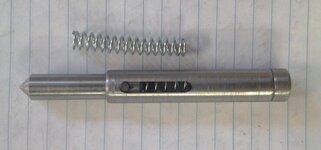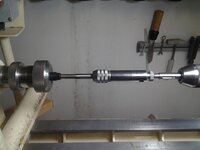MartinPens
Member
Well, I've taken the plunge.
I jumped at the HF 7 x 12 which was on sale and then had a 20% coupon.
This is a wordy post as I am so full of info. Bear with me as I get through this.
I have scoured the threads, searched, youtubed, and read myself blind for two days. (just getting started) There is so much great info and resources on this site - it's amazing. I have followed many of the pointers from this site mini-lathe.com home page and will be reading on this site for a long time!
These threads are very awesome:
http://http://www.penturners.org/forum/f56/threading-using-taps-dies-131653/
http://http://www.penturners.org/forum/f56/tap-dies-reference-spreadsheet-132281/
The list goes on and on and the library has great resources on kitless pens as well.
So here is the main thing I'm wanting to hone down.
I usually over-buy stuff when I get something new and end up spending way too much money on stuff I don't need. I know many of you have given advice several times over and I have read many threads and posts. I'm trying not to duplicate my questions, but I'm need to ask them anyhow.
I would like to be able to:
--cut my own threaded fittings out of lightweight metal.
--use it to do more precision cuts for kitless pens - tap and die threading.
--make threaded aluminum mandrels.
--cut precision delrin bushings for between center turning work
So that's just a start.
I prefer collets over jawed chucks.
I want a sliding tail stock
I want precision holes in the middle of my turning stock
Here is what I'm looking at purchasing. Am I looking in the right direction or am I wasting money - in your opinion. (there is a similar thread to this, but it was for someone buying a larger metal lathe and I'm looking for advice for my smaller lathe)
Short Arbor Drill Chuck http://http://www.amazon.com/Drill-Chuck-2MT-Short-Arbor/dp/B002YPHS7M
Quick change tool post Quick Change Tool Post Set by A2Z CNC 2461 - LittleMachineShop.com
Tail stock cam lock kit http://www.littlemachineshop.com/products/product_view.php?ProductID=2018
Snap Ring pliers http://www.amazon.com/TEKTON-3578-Universal-Snap-Pliers/dp/B000NPPAUC/ref=sr_1_2?ie=UTF8&qid=1433036957&sr=8-2&keywords=snap+ring+pliers
Collet Chuck COLLET CHUCK FOR ER-32 (80MM DIAMETER.) (3901-5032): Cutting Tool Holders: Amazon.com: Industrial & Scientific
Collets http://www.amazon.com/AutoSets-12Pcs-Collet-Chuck-ER-32/dp/B00T9FLYG6/ref=sr_1_2?ie=UTF8&qid=1433044172&sr=8-2&keywords=er32+collets
Spanner wrench Red Collet Chuck Wrench Spanner for ER32 Clamping Nut - - Amazon.com
I need basic cutting tools that are already sharpened ( I don't want to make my own) I have no idea what kind of basic tools to buy that will fit the quick change tool post??? HELP
What else do you see as essential??
I hope this thread can also be helpful for others who have purchased mini precision lathe.
Thank you!!
I jumped at the HF 7 x 12 which was on sale and then had a 20% coupon.
This is a wordy post as I am so full of info. Bear with me as I get through this.
I have scoured the threads, searched, youtubed, and read myself blind for two days. (just getting started) There is so much great info and resources on this site - it's amazing. I have followed many of the pointers from this site mini-lathe.com home page and will be reading on this site for a long time!
These threads are very awesome:
http://http://www.penturners.org/forum/f56/threading-using-taps-dies-131653/
http://http://www.penturners.org/forum/f56/tap-dies-reference-spreadsheet-132281/
The list goes on and on and the library has great resources on kitless pens as well.
So here is the main thing I'm wanting to hone down.
I usually over-buy stuff when I get something new and end up spending way too much money on stuff I don't need. I know many of you have given advice several times over and I have read many threads and posts. I'm trying not to duplicate my questions, but I'm need to ask them anyhow.
I would like to be able to:
--cut my own threaded fittings out of lightweight metal.
--use it to do more precision cuts for kitless pens - tap and die threading.
--make threaded aluminum mandrels.
--cut precision delrin bushings for between center turning work
So that's just a start.
I prefer collets over jawed chucks.
I want a sliding tail stock
I want precision holes in the middle of my turning stock
Here is what I'm looking at purchasing. Am I looking in the right direction or am I wasting money - in your opinion. (there is a similar thread to this, but it was for someone buying a larger metal lathe and I'm looking for advice for my smaller lathe)
Short Arbor Drill Chuck http://http://www.amazon.com/Drill-Chuck-2MT-Short-Arbor/dp/B002YPHS7M
Quick change tool post Quick Change Tool Post Set by A2Z CNC 2461 - LittleMachineShop.com
Tail stock cam lock kit http://www.littlemachineshop.com/products/product_view.php?ProductID=2018
Snap Ring pliers http://www.amazon.com/TEKTON-3578-Universal-Snap-Pliers/dp/B000NPPAUC/ref=sr_1_2?ie=UTF8&qid=1433036957&sr=8-2&keywords=snap+ring+pliers
Collet Chuck COLLET CHUCK FOR ER-32 (80MM DIAMETER.) (3901-5032): Cutting Tool Holders: Amazon.com: Industrial & Scientific
Collets http://www.amazon.com/AutoSets-12Pcs-Collet-Chuck-ER-32/dp/B00T9FLYG6/ref=sr_1_2?ie=UTF8&qid=1433044172&sr=8-2&keywords=er32+collets
Spanner wrench Red Collet Chuck Wrench Spanner for ER32 Clamping Nut - - Amazon.com
I need basic cutting tools that are already sharpened ( I don't want to make my own) I have no idea what kind of basic tools to buy that will fit the quick change tool post??? HELP
What else do you see as essential??
I hope this thread can also be helpful for others who have purchased mini precision lathe.
Thank you!!
Attachments
Last edited:

